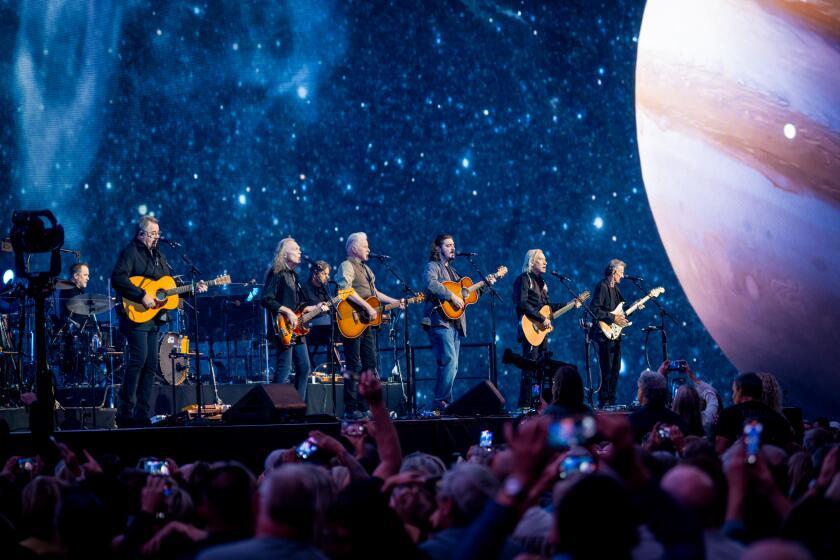Louis Armstrong--the Name Still Defines the Music
Louis Armstrong is jazz.
Not was--is. More than any other artist he has become a synonym for an entire century of an American art form. As trumpeter and no less as singer, he exerted an influence that has carried through to this day. Yet as a human being he was both idolized as a creative genius and reviled as a musical sellout and an Uncle Tom.
A complex and enigmatic figure beneath the clowning surface, he drew no arbitrary line between artistry and entertainment. By the 1950s--when the recent reissue “The California Concerts,” on Decca Records, was made--he believed in putting on a show.
What lay behind that comedy-oriented facade? Not many knew, and few cared; to most Americans, white and black alike, he was Our Beloved Louis.
However, this writer knew him for almost 40 years, produced several of his concerts and recordings, received many of his rambling, personally typewritten letters, went to New Orleans to see him crowned King of the Zulus in the 1949 Mardi Gras parade, heard him fronting everything from a polyphonic New Orleans combo to a pop-style big band, and had a pretty good fix on how he felt about his music and his private and public personas.
First you have to consider the world in which he was born on July 4, 1900 (as he liked to tell it, though his birth certificate shows the date was Aug. 4, 1901).
It was a world in which it seemed necessary to go along with certain facts of segregated life. This included self-derogation. Hence, his jokes about Man-Tan (a tanning cream of the ‘50s), his reference to one of his musicians as “Bing Crosby in Technicolor” and his use, until someone stopped him, of the word darkies in his famous theme song “Sleepy Time Down South.” What was perceived by some observers as Uncle Tomfoolery was pure and simple pragmatism.
Personal observation convinced me that Louis was a man of simple pleasures, rarely aroused to anger, who, despite a limited education, became a fluent writer with a style as personal as the sound of his horn. He took great delight in sitting down at his portable typewriter backstage after the show, lighting a joint and putting into type whatever amusing or reflective thoughts came to his head.
(His lifelong use of marijuana, about which he boasted openly in his later years, did him no apparent harm, according to Dr. Gary Zucker, one of his physicians, quoted in James Lincoln Collier’s uneven, controversial 1983 biography “Louis Armstrong: An American Genius,” published by Oxford University Press.)
Armstrong, who died July 6, 1971, believed in everything he played and sang, whether it was “West End Blues” (one of his late-’20s masterpieces) or some trivial tune like “Jeepers Creepers.” This was symptomatic of another line he never cared to draw--between jazz and pop music. Nor did he make racial distinctions in his hiring policy. He had a close friendship and a shared mutual admiration with Jack Teagarden, the white trombonist and singer who toured in his band for four years.
Satchmo was one of the most misunderstood musicians of his day. Critics could never figure out why, when he led a big band (off and on from 1929 until 1947), he admired and imitated the quavering saxes and spineless sound of the Guy Lombardo band. His answer was simple: “They play the melody.”
“The California Concerts,” a valuable if heavily flawed document, is a clear depiction of the trumpeter-singer-entertainer in his later years. His gravelly voice by then was the source of a thousand imitations; his horn had retained its pristine purity no matter what the setting.
On the blues tunes, particularly the two takes of “Back o’ Town Blues,” Armstrong is at his glorious best; never playing a torrent of notes, he makes every phrase meaningful. In his vocal on “Lazy River,” he strips the melody to its essentials. This same deceptive simplicity brings a haunting warmth to “The Gypsy,” “Our Monday Date” (co-featuring the composer, pianist Earl Hines) and Satchmo’s own ballad “Someday,” which offers one of his rare muted solos.
To truly assess his genius in its formative innovative stages, readers are invited to investigate such essential sources as “Armstrong Vol. III: The Hot Fives and Sevens” and “Vol. IV: Armstrong and Earl Hines,” both on Columbia, and “Great Original Performances 1923-31,” on BBC.
Jazz trumpet began with Louis, and from Satchmo it evolved slowly to the more complex Roy Eldridge, from Eldridge to Dizzy Gillespie and thence to Miles Davis and on down the line. True, Armstrong had a mentor, King Oliver, on whose recordings he was heard as a sideman, but his was the influence that circumnavigated the jazz world. Time, far from relegating Satchmo to a kindly but condescendingly regarded limbo, has aged him like vintage wine, as it has aged every world-class soloist since jazz began.
More to Read
The biggest entertainment stories
Get our big stories about Hollywood, film, television, music, arts, culture and more right in your inbox as soon as they publish.
You may occasionally receive promotional content from the Los Angeles Times.










